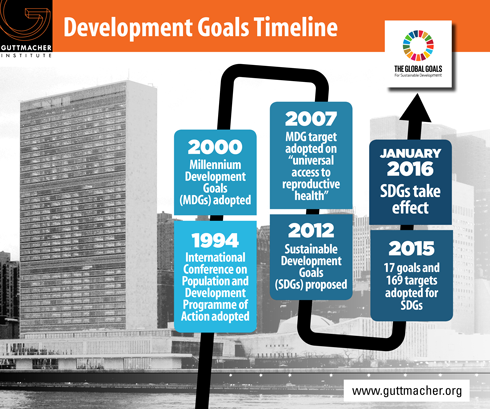The Sustainable Development Goals (SDGs), which will define the global development agenda for the next 15 years, were formally adopted at a United Nations summit in September 2015. The SDGs will, to a significant degree, drive the allocation of global resources and determine policy priorities between now and 2030 on a range of important issues—including sexual and reproductive health and rights (SRHR).

A new analysis published in the Guttmacher Policy Review lays out the historical context and significance of the SDG process for SRHR. The analysis also calls on governments and other stakeholders to embrace the SDGs and lays out various indicators that can be used at the global and national levels to measure progress toward achieving goals related to SRHR—and even to advance SRHR beyond what is outlined in the new development goals.
"It’s significant that sexual and reproductive health and rights issues are now recognized explicitly and from the outset as integral to the achievement of the SDGs, since that was not the case with the previous iteration of global development goals," says Alanna J. Galati, author of the new analysis. "The next hurdle is to ensure that countries adopt, adapt to and commit to these global goals."
The SDGs consist of 17 goals and 169 targets to eradicate poverty, promote human dignity and rights, and protect the environment. One key issue is measuring progress to guide implementation of the SDGs and verify their success. The UN Statistical Commission will formally approve a global monitoring framework, including a set of indicators, for the SDGs, in March 2016.
Galati describes how a consultative process led by the Guttmacher Institute is intended to inform this process through specific indicator recommendations on SRHR. Guttmacher convened policy and technical experts to propose a list of key indicators that reflect core SRHR principles and outcomes, taking into account topics identified as a high priority by advocates and whether reliable data are available for most countries.
As a reflection of how fundamental SRHR are to attaining broader development goals, the indicators that emerged from this process fall under three different SDG goals, those on health (Goal 3), education (Goal 4) and gender equality (Goal 5). Moreover, achieving better health and ensuring equal rights for women and girls are inextricably linked to the success of other key goals including reducing poverty and inequality.
"Ultimately, money and political will need to come together to turn the SDG declarations into action," says Galati. "As the single largest donor to the developing world—for family planning and reproductive health assistance, as well as more generally—the United States has been a strong leader in this area for decades. At this important global moment, U.S. leadership is once again vital."
Galati lists several ways in which the U.S. government can demonstrate leadership in advancing SRHR as part of the SDG process. For example, the U.S. Agency for International Development could help refine existing measurement systems, such as the Demographic and Health Surveys, and help create new measures to reflect current priorities. Also, the U.S. government should increase its financial commitment to family planning and reproductive health abroad to at least to $1 billion, from the current $610 million.
Full article: "Onward to 2030: Sexual and Reproductive Health and Rights in the Context of the Sustainable Development Goals," by Alanna J. Galati